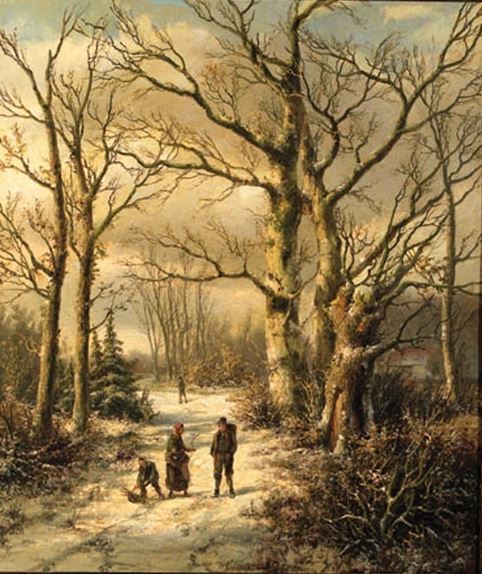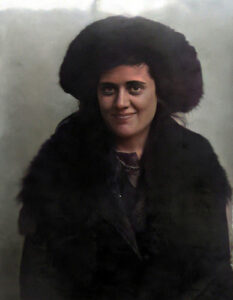b.1849 – d.1902 – Dutch Artist
Introduction

Out of sight, out of mind and forgotten might have been an epitaph on his headstone, if he had one, because once this talented artist was admitted to Banstead Asylum in 1888 his family, friends and the world at large seem to have lost any personal interest in him, remembering only the wonderful paintings he had produced.
The Mutual Art website states “Hendrik Barend Koekkoek was a Dutch 19th Century painter who was born in 1849. Hendrik Barend Koekkoek’s work has been offered at auction multiple times, with realized prices ranging from US$362 to US$18,541, depending on the size and medium of the artwork. Since 1998 the record price for this artist at auction is US$18,541 [~£13k] for Woodgatherers in a winter forest [shown here], sold at Christie’s Amsterdam in 1998. The artist died in 1909 (sic).”
The UK General Register Office recorded in 1902 that Hendrick B. Koekkoek’s age at death was 45, but both his name and age were incorrectly recorded, however this information would have been provided by the asylum at death.
Barend Hendrik Koekkoek’s true age when he died was 52, having been born on 22 November 1849 in Amsterdam, Holland. From the information found, it seems that Barend preferred to use his middle name “Hendrik” (possibly to distinguish himself from older, and very successful uncle Barend Cornelius), so that is how he is referred to here.
Family
Hendrik was the youngest and fourth son of 19th Century Dutch painter Hermanus Koekkoek (1815-1882) and his wife Johanna Maria (nee de Soet). Hendrik’s paternal grandfather was the Dutch painter Johannes Hermanus Koekkoek, whose sons and grandsons were prolific with their creations of landscape and marine paintings.
Hendrik had five siblings: Hermanus born on 8 December 1836, Willem born on 3 January 1839, Johannes Hermanus Barend born on 6 July 1840, Anna Elisabeth born on 15 January 1842 and Anna Paulina Catharina (or Maria) born on 12 September 1856.
Encouraged and taught by his father, and his uncle Marinus Adrianus Koekkoek, Hendrik starting painting in 1864 and was soon producing landscape, forest, and marine paintings that were described by others as being of a ‘romantic’ style. Hendrik’s paintings can be found in several museums, including the museum Paul Tetar van Elven in Delft, Holland. They are signed H. B. Koekkoek. [Koekkoek means ‘cuckoo’ in Dutch].
Marriage & London
On 3 January 1878, Hendrik was aged 28 when he married 23-year-old Carolina Allardina Cornelia Pierson in Rijswijk, Holland. Later that year the couple were in London, England, possibly joining Hendrik’s older brother Hermanus. Hermanus had married Cornelia Muller in Amsterdam in 1863 and moved to London where their daughter Johanna Maria was born on 18 October 1865. In 1878 Hermanus was living at 16 Charlotte Street, Bedford Square, London, and was not only an artist but also working as an international art dealer out of his London art gallery at 72 Piccadilly, London.

On 27 September 1878, Carolina gave birth to their first daughter Johanna Maria. Her birth was registered in the Pancras registration district before the family moved back to Amsterdam. Sadly, six-month-old Johanna died in Amsterdam on 18 March 1879.
Hendrik and Carolina’s second daughter, who was named exactly after her mother, was born on 9 December 1879 in Amsterdam. Sometime after her birth, the family moved back to England. The 1881 census records that on the night of 3 April, Hendrik, his wife Caroline (sic) and one-year-old daughter Caroline (sic), along with one domestic servant, were living at 241 Hampstead Road, Regents Park, London.


Hendrik’s occupation was recorded as an Artist/Painter. Later that year their daughter Henrietta Barendina was born in St Pancras, and their son Louis John was born on 10 April 1883, registered incorrectly as Kockkock.
Lunacy

On Saturday 1 December 1888, Hendrik was aged 39 when he was admitted into the St John’s Road Workhouse in Islington. It was noted that he was an artist, married, and that he was a member of the religious group known as the Plymouth Brethren. He was admitted into the ‘Ishmael Ward‘ which was the Men’s Lunatic ward (All the wards had scriptural names).
The UK Lunacy Patients Admission Register record that on Tuesday 4 December 1888, being mis-recorded as aged 32, he was discharged into the care of the London County Council Lunatic Asylum in Banstead, Surrey. The Banstead Asylum’s ‘Statement of Particulars’ actually stated that Hendrick was admitted the day before on 3 December. It was noted that he had recently suffered his first ‘attack’ which had lasted 5 weeks. The cause of the ‘attack’ was unknown, but he was not epileptic or suicidal. It recorded that Hendrick was married, an artist and that his religion was Brethan. His last address was noted as being 101 Elthorne Road, Hornsey. Caroline (wife) was recorded as his next of kin who was to be notified of his death when it happened. The 1889 Electoral Roll however still had him listed as living at 90 St Johns Road, Islington.

Hendrik’s family were recorded on the 1891 census as living at 2 Handley Road, Islington. Caroline was recorded as being a wife living on her own means, while Caroline, Henrietta and Louis were recorded as being scholars. Both Henrietta and Louis were recorded as being born in St Pancras, London.

The enumerator who took the census in Banstead Asylum on 5 April 1891 did not record the inmate’s full names and just referred to each by their initials. Hendrik appeared as HEK [not HBK], a 34-year-old lunatic inmate who was married and had formerly been an artist.
On 21 August 1899, Hendrik was moved from the Banstead Asylum to the new Manor Asylum that had been formerly opened by the London County Council that year on the Horton Estate in Epsom. Hendrick’s admission form states that he was aged 43 and that he was patient 93 to be admitted to the asylum. A copy of the Banstead Asylum’s 1888 ‘Statement of Particulars’ was recorded but noted that Caroline and her children had moved away from London to 57 Winstanley Crescent, Ramsgate, Kent.
The facts indicating his insanity were observed at his examination as “Believes he is going to be killed, says he is lost repeatably, asks if he is saved – says he has sinned against the Holy Grail but does not know how”. Notes made about his mental health were recorded as “Stupid & weak minded. Says he came here to be made a doctor. His memory is bad. Does not know the year or month”.
Examination showed him to be in a fairly-good physical condition. The doctors described him as having vague facial expressions, good hearing and teeth, a pale complexion, grey thinning hair and hazel-coloured eyes. His only physical concern was that he was suffering from double mitral disease of the heart, which he could have had since birth.
Mentally he is not improved and is much ? and shows marked loss of memory. Fair health. {signature}
There is not any improvement or mental or physical change in this patient. He works steadily and is well-behaved. {signature}
Is ?devoluted ?oom speaks to anyone. Works well at the stores & is in fair health. {initial}There is no change in his mental or physical condition. Fair health. {initial}
He is weak-minded ? ? speaks to anyone & has no memory. Works in the stores. Fair health. {initial}
He shows no mental improvement. Cannot converse rationally & ? speaks to anyone. ? ? health fair. {initial}
There is no change to note in his mental condition. Fair health. {initial}
Is childish & weak-minded and cannot converse. Quiet & well behaved & works well in the ?. Fair health. {initial}
There is no change in his mental condition. Health fair. {initial}
Weak-minded, childish & incapable of where? ? ?. Well marked mitral disease. Moderate health. {initial}
Was this day transferred to Horton Asylum was discharged as not improved.
Transcript of “Progress of Case”, [dates not clear enough to see]
When the 1901 census was taken, he and the other pauper inmates were again just recorded using their initials.

Caroline and her children were recorded as still living at 57 Winstanley Crescent in Ramsgate, Kent.

Caroline was once again recorded on the census as married and living on her own means, while daughter Caroline was working as a self-employed music teacher. It seems that Henrietta was not employed but 16-year-old Louis was an apprentice coach painter.
Death
Hendrik was admitted into Epsom’s second newly opened Horton Asylum on 3 March 1902.

Just a few weeks later (41-days to be precise), on 13 April 1902, he died and was buried 5-days later on 18 April in grave 3 in Horton Estate Cemetery. The Horton Cemetery Burial Register noted that his religion as Church of England. His official death is incorrectly recorded in the General Register Office as ‘Kock-Kock’ instead of ‘Koekkoek’.
Family after Hendrick
Whether his family knew of his death is unclear as it would seem that Hendrik was just forgotten after being admitted to the Banstead Asylum with one website stating that nothing is known about his last years up to his death, and with some sources stating that he died c1909. Some sites report Hendrick died in 1909, when in fact it was Hendrick’s brother Hermanus ‘H Koekkoek’ that died 4 June 1909 in the Bellevue Hotel, The Hague, Holland. His effects were valued at just over £814.
On 20 August 1902, Hendrik’s daughter Henrietta was admitted to the City Road Workhouse in Holborn where she remained until 4 September 1902. Why she was there is currently unknown. The following year, on 23 May 1903, she attended her Confirmation in St John the Evangelist Church in Hammersmith and appears to have died unmarried in 1960.
Caroline recorded herself as Hendrik’s widow when she filled out the 1911 census. Whether she had been officially informed that he had died is unknown. She also recorded that she had had four children, but one had died. She and her eldest daughter Caroline were living at 2 Alma Road in Ramsgate, Kent.

Caroline was working now as a dressmaker while her daughter was working as an attendant at a local entertainment place called Marina Hall. Son Louis was lodging at 7 Weston Street, Kings Cross Road, Clerkenwell and working as a coach painter. The whereabouts of Henrietta, at this moment, is unknown.
When Louis married Louisa Haestier in 1920 in Islington, Louisa’s father was recorded as being a deceased waiter. It seems strange then, that Hendrik was described as an artist without any mention of him being deceased (did he know?). Louis and Louisa’s daughter Rosina Ivy was born in 1921.

Hendrik’s widow Caroline was aged 68 when she died in 1922 in Islington. What happened to his daughter Caroline is uncertain although there is a marriage in 1929 to a Harry Kemp that might have been hers.
Authors Notes:
On 16 May 1907, a female named Caroline Koekkoek was admitted to Horton Asylum, where she stayed until 22 October 1909. Her discharge tick was marked under ‘Reld’, which was the abbreviation for ‘Relieved’ meaning she was on the road to recovery and possibly transferred to another hospital. This line of enquiry is currently unresearched.





